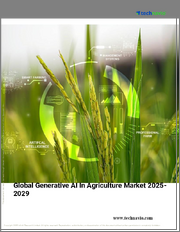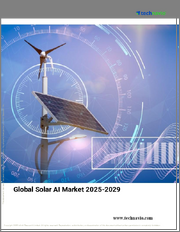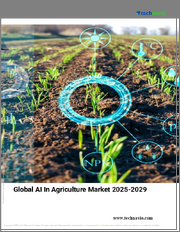
|
시장보고서
상품코드
1761875
세계의 농업 분야 인공지능 시장 조사 보고서 : 산업 분석, 규모, 점유율, 성장, 동향, 예측(2025-2033년)Global Artificial Intelligence in Agriculture Market Research Report- Industry Analysis, Size, Share, Growth, Trends and Forecast 2025 to 2033 |
||||||
농업 분야 인공지능 세계 시장 규모는 2024년 31억 5,000만 달러에서 2033년에는 248억 6,000만 달러로 성장하여 2026-2033년 예측 기간 동안 25.82%의 견조한 연평균 성장률(CAGR)을 나타낼 것으로 예측됩니다.
농업 분야 인공지능 시장은 농업 부문이 생산성과 지속가능성을 높이기 위해 기술을 점점 더 많이 도입함에 따라 괄목할 만한 성장이 예상됩니다. 세계 인구는 2050년까지 97억 명에 달할 것으로 예상되며, 효율적인 식량 생산 방식에 대한 수요는 그 어느 때보다 절실합니다. 머신러닝, 컴퓨터 비전, 예측 분석과 같은 AI 기술은 데이터 기반 의사결정을 가능하게함으로써 기존 농업 관행에 혁명을 일으키고 있습니다. 정밀농업에서 작물 모니터링 및 수확량 예측에 이르기까지 AI는 농업 종사자들이 자원 활용을 최적화하고 낭비를 줄이며 작물의 품질을 향상시킬 수 있도록 돕고 있습니다. 농업 환경이 진화함에 따라 AI 솔루션의 통합은 식량 안보와 환경적 지속가능성 문제를 해결하는 데 있어 매우 중요합니다.
AI 알고리즘이 탑재된 드론은 항공 촬영 및 작물 건강 평가에 활용되어 농부들에게 실시간으로 농장에 대한 인사이트를 제공하고, AI 알고리즘이 탑재된 센서와 IoT 장치는 토양 상태, 날씨 패턴, 해충 활동 등을 지속적으로 모니터링하여 적시에 개입하고 정보에 입각한 조치를 취할 수 있게 해줍니다. 또한, AI 기반 센서와 IoT 장치는 토양 상태, 날씨 패턴, 해충의 활동을 지속적으로 모니터링하여 적시에 개입하고 정보에 입각한 의사결정을 내릴 수 있도록 돕습니다. 농업 종사자들이 이러한 첨단 기술을 점점 더 많이 채택함에 따라 농업용 AI 솔루션에 대한 수요가 급증하고 시장이 크게 성장할 것으로 예상됩니다.
또한, 지속가능성과 환경 보호에 대한 관심이 높아지면서 농업 분야에서 AI의 도입이 가속화되고 있습니다. 소비자들이 식량 생산이 환경에 미치는 영향에 대한 인식이 높아짐에 따라 자원 소비를 최소화하고 탄소 배출량을 줄이는 지속가능한 농업에 대한 수요가 증가하고 있으며, AI 기술은 농업 종사자들이 투입물을 최적화하고 작물의 복원력을 높이는 정밀농업 기술을 도입할 수 있도록 지원함으로써 이러한 전환을 촉진하고 있습니다. 이러한 전환을 촉진하고 있습니다. 농업 분야 인공지능 시장이 계속 진화하는 가운데, 혁신, 지속가능성, 데이터 기반 의사결정에 대한 중요성이 성장의 주요 동력이 될 것이며, 복잡해지는 농업 환경에서 관련성을 확보할 수 있을 것으로 보입니다.
당사의 보고서는 고객에게 다양한 산업 및 시장에 대한 포괄적이고 실용적인 인사이트를 제공하기 위해 세심하게 작성되었습니다. 각 보고서는 시장 상황을 완전히 이해하기 위해 몇 가지 중요한 요소를 포함하고 있습니다.
시장 개요 : 정의, 분류, 산업 현황 등 시장에 대한 자세한 소개.
시장 역학 : 시장 성장에 영향을 미치는 주요 촉진요인, 억제요인, 기회 및 과제를 자세히 분석합니다. 이 섹션에서는 기술 발전, 규제 변화, 새로운 트렌드 등의 요인을 검토합니다.
세분화 분석 : 제품 유형, 용도, 최종사용자, 지역 등의 기준에 따라 시장을 명확한 부문으로 분류합니다. 이 분석을 통해 각 부문의 성과와 잠재력을 파악할 수 있습니다.
경쟁 상황 : 시장 점유율, 제품 포트폴리오, 전략적 이니셔티브, 재무실적 등 주요 시장 진입기업에 대한 종합적인 평가. 주요 기업들이 채택하고 있는 경쟁 역학 및 주요 전략에 대한 인사이트이 포함되어 있습니다.
시장 예측 : 과거 데이터와 현재 시장 상황을 바탕으로 일정 기간 동안 시장 규모와 성장 추세를 예측합니다. 여기에는 정량적 분석과 향후 시장 궤적을 보여주는 그래프 표시가 포함됩니다.
지역 분석 : 지역별 시장 성과를 평가하고 주요 시장 및 지역 동향을 파악할 수 있습니다. 지역 시장 역학 및 비즈니스 기회를 이해하는 데 도움이 됩니다.
새로운 트렌드와 기회 : 현재 시장 동향과 새로운 시장 동향, 기술 혁신, 잠재적 투자 대상 부문을 식별합니다. 향후 개발 및 성장 전망에 대한 인사이트를 제공합니다.
목차
제1장 서문
제2장 주요 요약
- 시장 하이라이트
- 세계 시장 현황
제3장 농업 분야 인공지능 산업 분석
- 소개 : 시장 역학
- 시장 성장 촉진요인
- 시장 성장 억제요인
- 시장 기회
- 산업 동향
- Porter's Five Forces 분석
- 시장 매력 분석
제4장 밸류체인 분석
- 밸류체인 분석
- 원료 분석
- 원료 리스트
- 원료 제조업체 리스트
- 주요 원료 가격 동향
- 잠재적 바이어 리스트
- 마케팅 채널
- 직접 마케팅
- 간접 마케팅
- 마케팅 채널 발전 동향
제5장 농업 분야 인공지능 세계 시장 분석 : 구성요소별
- 구성요소별 개요
- 구성요소별 과거·예측 데이터 분석
- 하드웨어
- 소프트웨어
- 서비스
제6장 농업 분야 인공지능 세계 시장 분석 : 기술별
- 기술별 개요
- 기술별 과거·예측 데이터 분석
- 머신러닝과 딥러닝
- 예측 분석
- 컴퓨터 비전
제7장 농업 분야 인공지능 세계 시장 분석 : 용도별
- 용도별 개요
- 용도별 과거·예측 데이터 분석
- 정밀농업
- 드론 분석
- 농업 로봇
- 가축 모니터링
- 노동 관리
- 기타
제8장 농업 분야 인공지능 세계 시장 분석 : 지역별
- 지역별 전망
- 소개
- 북미의 매출 분석
- 개요, 실적과 예측
- 북미 : 부문별
- 북미 : 국가별
- 미국
- 캐나다
- 멕시코
- 유럽의 매출 분석
- 개요, 실적과 예측
- 유럽 : 부문별
- 유럽 : 국가별
- 영국
- 프랑스
- 독일
- 이탈리아
- 러시아
- 기타 유럽
- 아시아태평양의 매출 분석
- 개요, 실적과 예측
- 아시아태평양 : 부문별
- 아시아태평양 : 국가별
- 중국
- 인도
- 일본
- 한국
- 호주
- 동남아시아
- 기타 아시아태평양
- 라틴아메리카의 매출 분석
- 개요, 실적과 예측
- 라틴아메리카 : 부문별
- 라틴아메리카 : 국가별
- 브라질
- 아르헨티나
- 페루
- 칠레
- 기타 라틴아메리카
- 중동 및 아프리카의 매출 분석
- 개요, 실적과 예측
- 중동 및 아프리카 : 부문별
- 중동 및 아프리카 : 국가별
- 사우디아라비아
- 아랍에미리트
- 이스라엘
- 남아프리카공화국
- 기타 중동 및 아프리카
제9장 농업 분야 인공지능 기업 경쟁 구도
- 농업 분야 인공지능 시장 경쟁
- 제휴/협력/합의
- 인수합병
- 신제품 발표
- 기타 개발
제10장 기업 개요
- 상위 기업의 시장 점유율 분석
- 시장 집중도
- Blue River Technology
- Climate LLC
- Corteva
- Deere & Company
- Ecorobotix SA
- Farmers Edge Inc.
- IBM
- Microsoft
- Trimble Inc.
- Valmont Industries Inc.
Global Artificial Intelligence in Agriculture Market size is anticipated to grow from USD 3.15 Billion in 2024 to USD 24.86 Billion by 2033, showcasing a robust Compound Annual Growth Rate (CAGR) of 25.82% during the forecast period of 2026 to 2033.
The Artificial Intelligence in Agriculture Market is poised for remarkable growth as the agricultural sector increasingly embraces technology to enhance productivity and sustainability. With the global population projected to reach 9.7 billion by 2050, the demand for efficient food production methods is more pressing than ever. AI technologies, including machine learning, computer vision, and predictive analytics, are revolutionizing traditional farming practices by enabling data-driven decision-making. From precision agriculture to crop monitoring and yield prediction, AI is empowering farmers to optimize resource utilization, reduce waste, and improve crop quality. As the agricultural landscape evolves, the integration of AI solutions will be crucial in addressing the challenges of food security and environmental sustainability.
Moreover, the rise of smart farming technologies is transforming the way farmers operate, with AI playing a central role in this evolution. Drones equipped with AI algorithms are being utilized for aerial imaging and crop health assessment, providing farmers with real-time insights into their fields. Additionally, AI-powered sensors and IoT devices are enabling continuous monitoring of soil conditions, weather patterns, and pest activity, allowing for timely interventions and informed decision-making. As farmers increasingly adopt these advanced technologies, the demand for AI solutions in agriculture is expected to surge, positioning the market for robust growth.
Furthermore, the increasing focus on sustainability and environmental stewardship is driving the adoption of AI in agriculture. As consumers become more conscious of the environmental impact of food production, there is a growing demand for sustainable farming practices that minimize resource consumption and reduce carbon footprints. AI technologies are facilitating this transition by enabling farmers to implement precision farming techniques that optimize inputs and enhance crop resilience. As the Artificial Intelligence in Agriculture Market continues to evolve, the emphasis on innovation, sustainability, and data-driven decision-making will be key drivers of growth, ensuring its relevance in an increasingly complex agricultural landscape.
Our reports are meticulously crafted to provide clients with comprehensive and actionable insights into various industries and markets. Each report encompasses several critical components to ensure a thorough understanding of the market landscape:
Market Overview: A detailed introduction to the market, including definitions, classifications, and an overview of the industry's current state.
Market Dynamics: In-depth analysis of key drivers, restraints, opportunities, and challenges influencing market growth. This section examines factors such as technological advancements, regulatory changes, and emerging trends.
Segmentation Analysis: Breakdown of the market into distinct segments based on criteria like product type, application, end-user, and geography. This analysis highlights the performance and potential of each segment.
Competitive Landscape: Comprehensive assessment of major market players, including their market share, product portfolio, strategic initiatives, and financial performance. This section provides insights into the competitive dynamics and key strategies adopted by leading companies.
Market Forecast: Projections of market size and growth trends over a specified period, based on historical data and current market conditions. This includes quantitative analyses and graphical representations to illustrate future market trajectories.
Regional Analysis: Evaluation of market performance across different geographical regions, identifying key markets and regional trends. This helps in understanding regional market dynamics and opportunities.
Emerging Trends and Opportunities: Identification of current and emerging market trends, technological innovations, and potential areas for investment. This section offers insights into future market developments and growth prospects.
SEGMENTATION COVERED IN THE REPORT
By Component
- Hardware
- Software
- Service
By Technology
- Machine Learning & Deep Learning
- Predictive Analytics
- Computer Vision
By Application
- Precision Farming
- Drone Analytics
- Agriculture Robots
- Livestock Monitoring
- Labor Management
- Others
- COMPANIES PROFILED
- Blue River Technology
- Climate LLC
- Corteva
- Deere & Company
- Ecorobotix SA
- Farmers Edge Inc.
- IBM
- Microsoft
- Trimble Inc.
- Valmont Industries Inc.
- The above list can be customized.
TABLE OF CONTENTS
1. PREFACE
- 1.1. Report Description
- 1.1.1 Objective
- 1.1.2 Target Audience
- 1.1.3 Unique Selling Proposition (USP) & offerings
- 1.2. Research Scope
- 1.3. Research Methodology
- 1.3.1 Market Research Process
- 1.3.2 Market Research Methodology
2. EXECUTIVE SUMMARY
- 2.1. Highlights of Market
- 2.2. Global Market Snapshot
3. ARTIFICIAL INTELLIGENCE IN AGRICULTURE INDUSTRY ANALYSIS
- 3.1. Introduction - Market Dynamics
- 3.2. Market Drivers
- 3.3. Market Restraints
- 3.4. Opportunities
- 3.5. Industry Trends
- 3.6. Porter's Five Force Analysis
- 3.7. Market Attractiveness Analysis
- 3.7.1 Market Attractiveness Analysis By Component
- 3.7.2 Market Attractiveness Analysis By Technology
- 3.7.3 Market Attractiveness Analysis By Application
- 3.7.4 Market Attractiveness Analysis By Region
4. VALUE CHAIN ANALYSIS
- 4.1. Value Chain Analysis
- 4.2. Raw Material Analysis
- 4.2.1 List of Raw Materials
- 4.2.2 Raw Material Manufactures List
- 4.2.3 Price Trend of Key Raw Materials
- 4.3. List of Potential Buyers
- 4.4. Marketing Channel
- 4.4.1 Direct Marketing
- 4.4.2 Indirect Marketing
- 4.4.3 Marketing Channel Development Trend
5. GLOBAL ARTIFICIAL INTELLIGENCE IN AGRICULTURE MARKET ANALYSIS BY COMPONENT
- 5.1. Overview By Component
- 5.2. Historical and Forecast Data Analysis By Component
- 5.3. Hardware Historic and Forecast Sales By Regions
- 5.4. Software Historic and Forecast Sales By Regions
- 5.5. Service Historic and Forecast Sales By Regions
6. GLOBAL ARTIFICIAL INTELLIGENCE IN AGRICULTURE MARKET ANALYSIS BY TECHNOLOGY
- 6.1. Overview By Technology
- 6.2. Historical and Forecast Data Analysis By Technology
- 6.3. Machine Learning & Deep Learning Historic and Forecast Sales By Regions
- 6.4. Predictive Analytics Historic and Forecast Sales By Regions
- 6.5. Computer Vision Historic and Forecast Sales By Regions
7. GLOBAL ARTIFICIAL INTELLIGENCE IN AGRICULTURE MARKET ANALYSIS BY APPLICATION
- 7.1. Overview By Application
- 7.2. Historical and Forecast Data Analysis By Application
- 7.3. Precision Farming Historic and Forecast Sales By Regions
- 7.4. Drone Analytics Historic and Forecast Sales By Regions
- 7.5. Agriculture Robots Historic and Forecast Sales By Regions
- 7.6. Livestock Monitoring Historic and Forecast Sales By Regions
- 7.7. Labor Management Historic and Forecast Sales By Regions
- 7.8. Others Historic and Forecast Sales By Regions
8. GLOBAL ARTIFICIAL INTELLIGENCE IN AGRICULTURE MARKET ANALYSIS BY GEOGRAPHY
- 8.1. Regional Outlook
- 8.2. Introduction
- 8.3. North America Sales Analysis
- 8.3.1 Overview, Historic and Forecast Data Sales Analysis
- 8.3.2 North America By Segment Sales Analysis
- 8.3.3 North America By Country Sales Analysis
- 8.3.4 United States Sales Analysis
- 8.3.5 Canada Sales Analysis
- 8.3.6 Mexico Sales Analysis
- 8.4. Europe Sales Analysis
- 8.4.1 Overview, Historic and Forecast Data Sales Analysis
- 8.4.2 Europe By Segment Sales Analysis
- 8.4.3 Europe By Country Sales Analysis
- 8.4.4 United Kingdom Sales Analysis
- 8.4.5 France Sales Analysis
- 8.4.6 Germany Sales Analysis
- 8.4.7 Italy Sales Analysis
- 8.4.8 Russia Sales Analysis
- 8.4.9 Rest Of Europe Sales Analysis
- 8.5. Asia Pacific Sales Analysis
- 8.5.1 Overview, Historic and Forecast Data Sales Analysis
- 8.5.2 Asia Pacific By Segment Sales Analysis
- 8.5.3 Asia Pacific By Country Sales Analysis
- 8.5.4 China Sales Analysis
- 8.5.5 India Sales Analysis
- 8.5.6 Japan Sales Analysis
- 8.5.7 South Korea Sales Analysis
- 8.5.8 Australia Sales Analysis
- 8.5.9 South East Asia Sales Analysis
- 8.5.10 Rest Of Asia Pacific Sales Analysis
- 8.6. Latin America Sales Analysis
- 8.6.1 Overview, Historic and Forecast Data Sales Analysis
- 8.6.2 Latin America By Segment Sales Analysis
- 8.6.3 Latin America By Country Sales Analysis
- 8.6.4 Brazil Sales Analysis
- 8.6.5 Argentina Sales Analysis
- 8.6.6 Peru Sales Analysis
- 8.6.7 Chile Sales Analysis
- 8.6.8 Rest of Latin America Sales Analysis
- 8.7. Middle East & Africa Sales Analysis
- 8.7.1 Overview, Historic and Forecast Data Sales Analysis
- 8.7.2 Middle East & Africa By Segment Sales Analysis
- 8.7.3 Middle East & Africa By Country Sales Analysis
- 8.7.4 Saudi Arabia Sales Analysis
- 8.7.5 UAE Sales Analysis
- 8.7.6 Israel Sales Analysis
- 8.7.7 South Africa Sales Analysis
- 8.7.8 Rest Of Middle East And Africa Sales Analysis
9. COMPETITIVE LANDSCAPE OF THE ARTIFICIAL INTELLIGENCE IN AGRICULTURE COMPANIES
- 9.1. Artificial Intelligence in Agriculture Market Competition
- 9.2. Partnership/Collaboration/Agreement
- 9.3. Merger And Acquisitions
- 9.4. New Product Launch
- 9.5. Other Developments
10. COMPANY PROFILES OF ARTIFICIAL INTELLIGENCE IN AGRICULTURE INDUSTRY
- 10.1. Top Companies Market Share Analysis
- 10.2. Market Concentration Rate
- 10.3. Blue River Technology
- 10.3.1 Company Overview
- 10.3.2 Company Revenue
- 10.3.3 Products
- 10.3.4 Recent Developments
- 10.4. Climate LLC
- 10.4.1 Company Overview
- 10.4.2 Company Revenue
- 10.4.3 Products
- 10.4.4 Recent Developments
- 10.5. Corteva
- 10.5.1 Company Overview
- 10.5.2 Company Revenue
- 10.5.3 Products
- 10.5.4 Recent Developments
- 10.6. Deere & Company
- 10.6.1 Company Overview
- 10.6.2 Company Revenue
- 10.6.3 Products
- 10.6.4 Recent Developments
- 10.7. Ecorobotix SA
- 10.7.1 Company Overview
- 10.7.2 Company Revenue
- 10.7.3 Products
- 10.7.4 Recent Developments
- 10.8. Farmers Edge Inc.
- 10.8.1 Company Overview
- 10.8.2 Company Revenue
- 10.8.3 Products
- 10.8.4 Recent Developments
- 10.9. IBM
- 10.9.1 Company Overview
- 10.9.2 Company Revenue
- 10.9.3 Products
- 10.9.4 Recent Developments
- 10.10. Microsoft
- 10.10.1 Company Overview
- 10.10.2 Company Revenue
- 10.10.3 Products
- 10.10.4 Recent Developments
- 10.11. Trimble Inc.
- 10.11.1 Company Overview
- 10.11.2 Company Revenue
- 10.11.3 Products
- 10.11.4 Recent Developments
- 10.12. Valmont Industries Inc.
- 10.12.1 Company Overview
- 10.12.2 Company Revenue
- 10.12.3 Products
- 10.12.4 Recent Developments
- 10.13.
- 10.13.1 Company Overview
- 10.13.2 Company Revenue
- 10.13.3 Products
- 10.13.4 Recent Developments



















